Understanding Acclimatization and High-Altitude Environments
Proper acclimatization during a mountaineering expedition is crucial for the safety and success of all climbers at high altitudes. In the sections below, we will explore the physiological processes that allow the body to gradually adjust to the reduced oxygen levels and harsh environmental conditions encountered at high elevations. With proper acclimatization, you can mitigate the negative effects of those high-altitude environments on your physical performance and overall well-being. It’s actually quite incredible that our body can acclimate to these conditions over time, allowing us to climb in good style.
- Oxygen Levels at Altitude
- Classification of Altitudes
- Physiological Impacts
- Importance of Acclimatization
- Acclimatization Schedules
- Pre-Acclimatization Strategies Before an Expedition
- Acclimatization Strategies During an Expedition
- Hypoxico Altitude Training Systems
- CTSS Speed Ascents
- More on Acclimatization
Oxygen Levels at Altitude
When we start looking at acclimatization and high-altitude environments, it’s important to understand how atmospheric pressure impacts the availability of oxygen at various altitudes. As you increase in altitude, the atmospheric pressure starts to decrease. Because of this, the air is thinner, but it still has about 21% oxygen present, which is the same percentage at sea level. The lower atmospheric pressure means that there is less oxygen available for uptake, which means your blood oxygen saturation (SpO2) will be impacted.
SpO2, or oxygen saturation, is a percentage that measures the amount of oxygen-carrying hemoglobin in the blood compared to the amount of hemoglobin that does not carry oxygen. At about 1,500m (5,000ft), chemoreceptors sense low oxygen pressure, triggering hypoxia (an oxygen deficiency in the body) and a variety of physiological reactions in your body, including the production of more hemoglobin, which thickens the blood.

Classification of Altitudes
It can be helpful to better understand how altitude can potentially affect the body at various altitudes, especially if you are just getting started with mountaineering and aren’t sure what to expect. It’s important to keep in mind that everyone responds differently to high altitudes, and each time you go to a high altitude, your body will respond differently. Just because you didn’t have any issues on Kilimanjaro doesn’t mean you won’t have problems on Aconcagua. The environment you are in and where you are located on the globe all play a role in acclimatization.
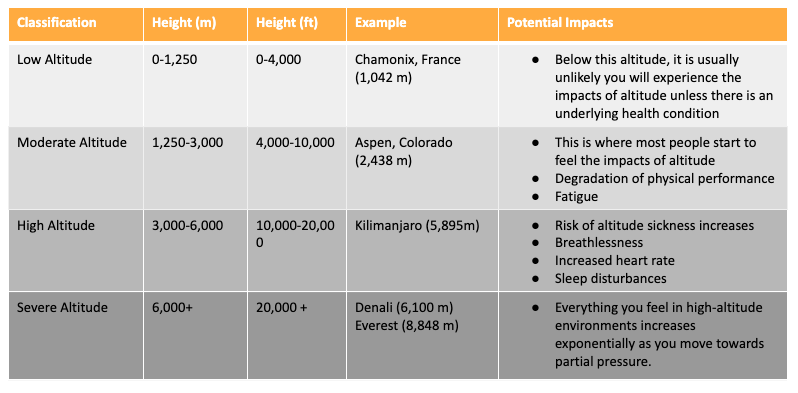
Physiological Impacts
The body undergoes several physiological changes to cope with the decreased oxygen availability and other environmental stressors. These adaptations occur over a period of days to weeks and help improve oxygen uptake and delivery to your tissues. Here are some of the key physiological changes that take place during acclimatization:
- Increased Breathing and Depth: One of the primary responses to high altitude is an increase in breathing rate and depth (ventilation). This helps to compensate for the reduced oxygen pressure in the air, allowing for greater oxygen intake and delivery to the bloodstream.
- Increased Heart Rate: Acclimatization will impact both resting and active heart rates to maintain cardiac output and blood pressure in response to the lower oxygen levels at altitude.
- Increased Urination: Acclimatization may involve changes in fluid balance, including increased urine output and changes in electrolyte levels, to help regulate blood volume and blood pressure at high altitudes.
- Blood Changes: To enhance oxygen transport, the body increases the production of red blood cells in response to hypoxia. This occurs primarily in the bone marrow, stimulated by the release of erythropoietin (EPO) from the kidneys. Higher red blood cell counts improve the blood’s oxygen-carrying capacity.
- Muscle Changes: With acclimatization, muscles may become more efficient at utilizing available oxygen. This adaptation helps to maintain physical performance at high altitudes despite reduced oxygen availability.
These physiological adaptations allow the body to function more effectively in low-oxygen environments and mitigate the negative effects of altitude on physical performance and well-being. Your body is doing some pretty cool things while you acclimate to allow you to reach the summit in good style. You will hear us press this issue over and over again: it’s incredibly important to remember that individual responses to altitude vary, and not everyone acclimatizes at the same rate or to the same extent. Some of the best climbers in the world need to allow more time for their bodies to adapt to altitude.
Importance of Acclimatization
Acclimatized climbers generally experience less discomfort and distress at high altitudes, allowing them to enjoy mountaineering more fully, recover more quickly, stave off altitude sickness, and increase overall physical performance. Here is a quick look at why it’s so important to acclimatize properly.
- Improved Physical Performance: Acclimatization allows the body to adapt to the reduced oxygen availability, which enhances physical performance. Climbers who acclimatize properly are better able to maintain strength, endurance, and mental clarity, which are essential for safe and successful ascents.
- Increased Oxygen Uptake: With acclimatization, the body increases its production of red blood cells and improves oxygen uptake efficiency by the muscles and tissues. This adaptation helps maintain adequate oxygen delivery to vital organs, reducing the risk of hypoxia and its associated symptoms.
- Better Temperature Regulation: High altitudes often come with extreme temperature variations, including intense sunlight during the day and freezing temperatures at night. Acclimatization allows the body to better regulate its temperature, reducing the risk of hypothermia or heat-related illnesses.
- Reduced Risk of Exhaustion and Injury: Climbers who are properly acclimatized are less likely to experience fatigue, exhaustion, or impaired judgment, reducing the risk of accidents and injuries on the mountain.
Prevention of Altitude Sickness: Acclimatization helps the body cope with the lower oxygen levels present at high altitudes. Without proper acclimatization, climbers are at risk of developing acute mountain sickness (AMS), which can range from mild symptoms like headaches and nausea to more severe conditions like high altitude pulmonary edema (HAPE) or high altitude cerebral edema (HACE).
CTSS Acclimatization Schedules
One of the most common questions we’re asked about acclimatization and high-altitude environments is how to predict what your body will do on your next climb. It’s imperative that anyone going into the mountains understands that individual responses to altitude vary, and not everyone acclimatizes at the same rate or to the same extent. Plus, your response each time will be different because of different environmental and physical factors, including how much water you’ve consumed, where you are in the world, and the overall weather conditions, all of which affect your ability to acclimatize on a particular expedition. Just because you acclimatized well on Kilimanjaro doesn’t mean your body will do the same on Aconcagua. Remember, some of the best climbers in the world need to allow more time for their bodies to adapt to altitude, and it’s okay if you’re in the same boat.
To acclimatize well, the body needs to be exposed gradually to new high points and then given time to adjust. Think of it like going to the gym, where we deliberately put stress on our muscles before letting them recover. When we return to the gym, we are stronger. Altitude and acclimatization work similarly, and this practice is often called climbing high and sleeping low.
On a well-planned acclimatization schedule, each jump in elevation is staggered by a rest/acclimatization day or a carry day. Our goal on a rest/acclimatization day is to reach a new high point (climbing high) in elevation before dropping back down to sleep low. This puts manageable stress on the body and prompts it to adjust to a new environment. Once we have exposed our body to that new high point, retreated, and rested, we can move up to a new elevation, and the process repeats.
CTSS Sample Acclimatization Schedules
For example, during our Everest Base Camp Trek, we generally stay two nights in each village and take a short acclimatization hike above the village on the rest/acclimatization day to reach a new high point. Despite the trail only being 40 miles, it takes us 11 days to reach Everest Base Camp because of the need to acclimatize along the way.
Another example is from our Aconcagua expedition, where we follow the same principle of climbing high and sleeping low, but it looks a little different as the acclimatization days double as carry days. When we climb Aconcagua, we take all the gear we need for the entire expedition with us, all the way up and down the peak. We spend two nights at most camps, using the first day as a carry day to bring a load of gear to the next camp and cache it before returning for a second night at our current camp. This carry day is also your acclimatization day since you will be climbing high and sleeping low. The second day is a move day when we climb back up to the gear we cached the day before and establish camp. Rest days are scattered throughout this itinerary to ensure climbers are prepared for their summit push.
On Mount Everest, a proper acclimatization schedule can take 6-8 weeks. From the time climbers arrive in Kathmandu, trek to Everest Base Camp, and undertake a series of rotations to subsequently higher points on the mountain, the body is making impressive physiological changes to allow the climber to ascend to 8,848 meters (29,032 feet). Acclimatization is exactly why it takes two months to climb Everest. Once a climber is fully acclimatized, the final rotation only takes 5-7 days from Everest Base Camp to the summit and back.
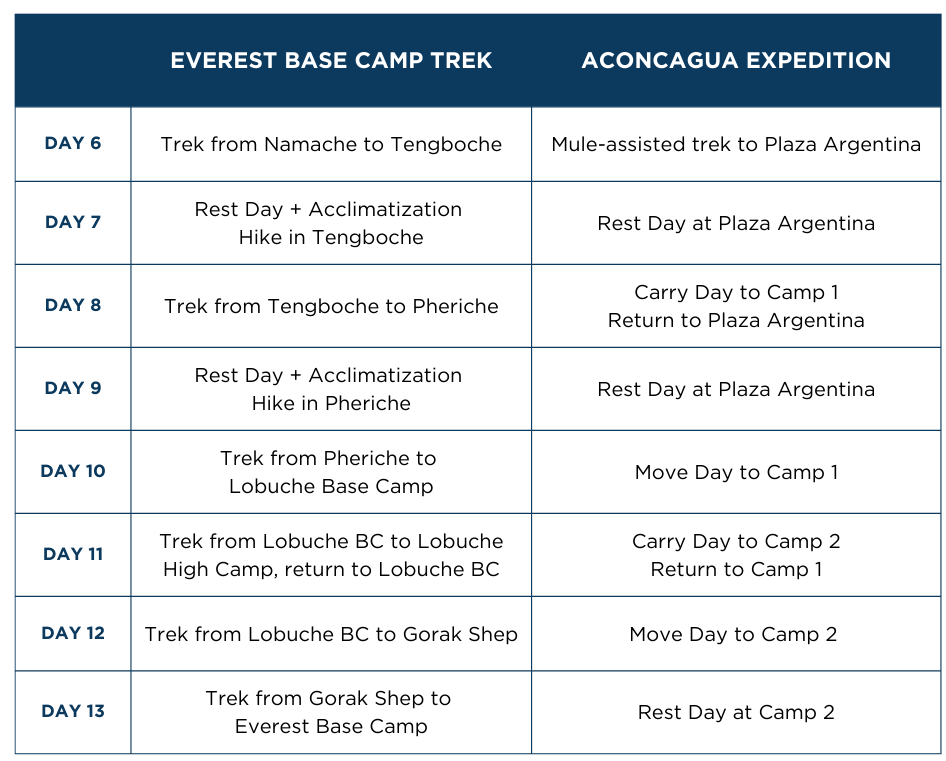
Pre-Acclimatization Strategies Before an Expedition
- Fitness Training: Your climb and acclimatization begins long before you step foot on the mountain. By incorporating proper training into your daily routine for at least six months before your departure date, you will help set yourself up for success as you acclimatize during your expedition. Remember, training doesn’t stop with just your fitness, and it’s crucial to be in top mental condition.
- Hypoxic Training: Hypoxic training involves exposing the body to reduced oxygen levels. This can be achieved through training in natural high-altitude environments to stimulate the physiological adaptations you will experience during your trip. Training in high-altitude environments will ultimately improve your performance and reduce susceptibility to altitude sickness during your expedition.
- Use of Hypoxico Tents and Chambers: If you are unable to travel to natural high-altitude environments, you can mimic the physiological adaptations experienced at altitude using Hypoxico Training Systems. These systems and devices allow mountaineers to acclimatize gradually at home in a controlled environment by reducing oxygen levels while sleeping or exercising.
Acclimatization Strategies During an Expedition
We employ a number of acclimatization strategies during our expeditions, which involve increasing altitude exposure in a deliberately unhurried manner, allowing the body time to adapt to the decreased oxygen levels, and taking rest days as a built-in feature of our itineraries. Here’s an overview of the acclimatization techniques we employ on all of our expeditions.
- Importance of Gradual Altitude Gain: A metered approach to altitude gain is critical for acclimatization because it allows the body to slowly adjust to decreasing oxygen levels. Climbing too quickly increases the risk of altitude sickness, as the body doesn’t have enough time to adapt.
- Slow Ascent Rates and Rest Days: Slow ascent rates and rest days are essential components of gradual ascent acclimatization. You’ve heard us say climb high, sleep low? These periods of venturing high and then sleeping lower allow our bodies to rest and make the critical adaptations for altitude. Rest days also provide an opportunity to monitor for symptoms of altitude sickness and adjust ascent plans accordingly.
- Hydration and Nutrition: On any expedition, hydration and nutrition play an integral role in how you feel in the mountains. On the flip side, due to long travel time, busy trip itineraries, and an all too often lack of appetite, it can also be hard to remember to adequately eat and drink. You must ensure that you don’t get behind on your food and fluid intake. To make things easier, we recommend training to eat and drink in the mountains along with your regular fitness training.
- Pharmacological Interventions: Medications can be used for altitude sickness prevention or treatment. Acetazolamide (Diamox) is a commonly prescribed medication that helps stimulate breathing and reduce the risk of altitude sickness. Other medications, such as dexamethasone or nifedipine, may be used for severe cases of altitude sickness. However, pharmacological interventions should be used judiciously, and climbers should be aware of potential side effects and interactions with other medications.
Hypoxico Altitude Training Systems
If you’re looking for a quicker timeline on the mountain, a hypoxic tent can shorten your expedition by facilitating acclimatization to high altitudes before your actual climb. Many climbers don’t have unlimited time off to pursue their mountain dreams and have busy lives with family and work, so utilizing a pre-acclimatization strategy that involves the use of a Hypoxico tent can help to shorten time away from work, family, and friends. Here’s how you can incorporate pre-acclimatization by using a hypoxic tent to expedite the acclimatization process.
- Pre-Trip Preparation: Before the mountaineering trip, set up the hypoxic tent in a comfortable and convenient location, over your bed or a guest bed if your pets or partner usually sleep with you and don’t want to also acclimatize. Ensure that the tent is properly installed and ventilated according to manufacturer instructions.
- Gradual Exposure: Begin using the hypoxic tent 6 – 8 weeks before your expedition. Start with a lower simulated altitude, typically equivalent to around 1,500 meters (5,000 feet) above sea level, and gradually increase the altitude over time. For every night that you sleep well, ascend 150 meters (500 feet). If you do not sleep well, remain at that altitude until you do, then ascend in altitude. Ascend until you have hit the altitude you are trying to acclimatize to.
- Consistent Use: Sleep in the hypoxic tent each night to expose your body to the reduced oxygen levels. Consistent nightly exposure helps stimulate physiological adaptations similar to those experienced at high altitudes, such as increased red blood cell production and improved oxygen utilization.
- Training Sessions: In addition to sleeping in the hypoxic tent, incorporate training sessions or workouts while breathing the reduced oxygen air. This can help enhance cardiovascular fitness and endurance, further preparing you for the physical demands of the mountaineering trip.
- Monitoring: Throughout the acclimatization process, monitor your response to the hypoxic exposure and adjust the altitude settings as needed. Pay attention to any symptoms of altitude sickness or discomfort and consult with a healthcare professional if necessary.
- Supplemental Training: While using the hypoxic tent, continue to engage in supplemental altitude training activities, such as hiking, climbing, or aerobic exercises, to further enhance acclimatization and physical conditioning.
By using a Hypoxico tent to simulate altitude exposure before the mountaineering trip, you can expedite the acclimatization process and reduce the time on an expedition by 30-50%. As always, if you are using a Hypoxico system, it’s essential to supplement your Hypoxico tent usage with other aspects of mountaineering preparation, including physical training, proper gear selection, and knowledge of altitude-related risks and safety protocols.
It’s important to note that Hypoxico systems should only be used in support of a Speed Ascent-style expedition and in collaboration with your mountaineering guide service. Traditional expeditions, which make up the majority of CTSS trips, include ample time for acclimatization, and using these systems may result in unnecessary pre-trip illnesses and a reduced ability to recover from your training.
CTSS Speed Ascents
Our Speed Ascent programs provide considerably shorter itineraries by taking advantage of pre-acclimatization technology in the comfort of your own home before you depart. It’s important to remember that you can’t cut corners to acclimatize, but you can save time on the mountain if you take advantage of the training systems that Hypoxico offers. Below are a few Speed Ascents that we offer.
Aconcagua
Having pre-acclimatized at home with our Speed Ascent program, you can fly directly into Plaza Argentina Base Camp by helicopter where you will meet your guides and teammates, skipping the long trek up the Vacas Valley.

Price: Starts from $9,995 USD
Dates: Dec 27, 2024 – Jan 10, 2025 and Feb 6 – 20, 2025
Trip Length: 15 days (standard itinerary is 20 days)
Mount Everest
Our Speed Ascent program is designed around a 40-day schedule, but we can offer a more aggressive 30-day schedule. Please note that the shorter schedule requires more pre-acclimatization at home.
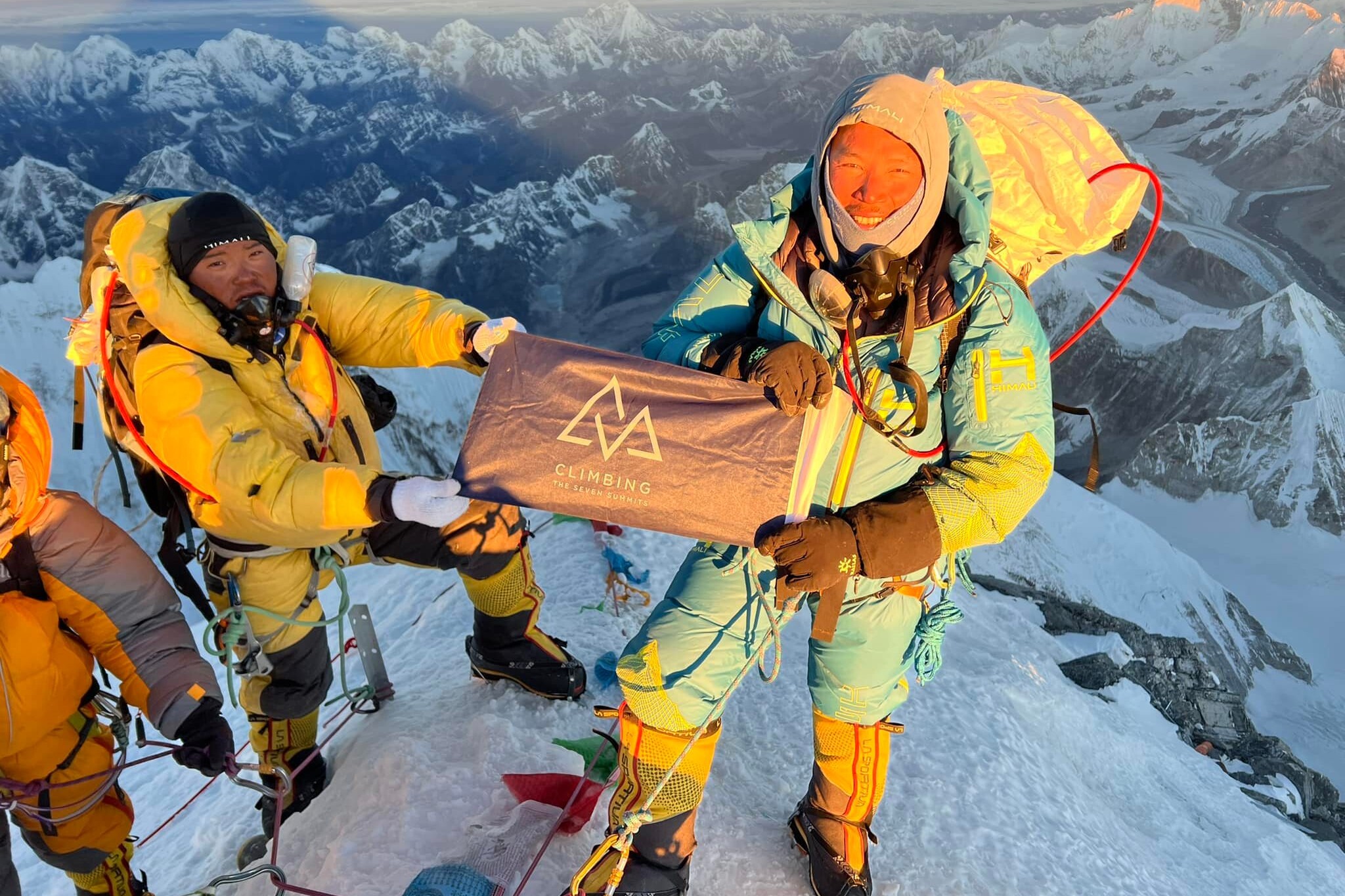
Price: Add $10,000 – $12,000 USD to your Everest program
Dates: Annually on April 12 (40-day) and April 20 (30-day)
Trip Length: 30 or 40 days (standard itinerary is 58 days)
Lhotse
We offer two different Speed Ascents, one with a personal Sherpa and the other with a private Western guide. All Speed Ascent climbers will join the team in Pheriche just before heading to Everest Base Camp.
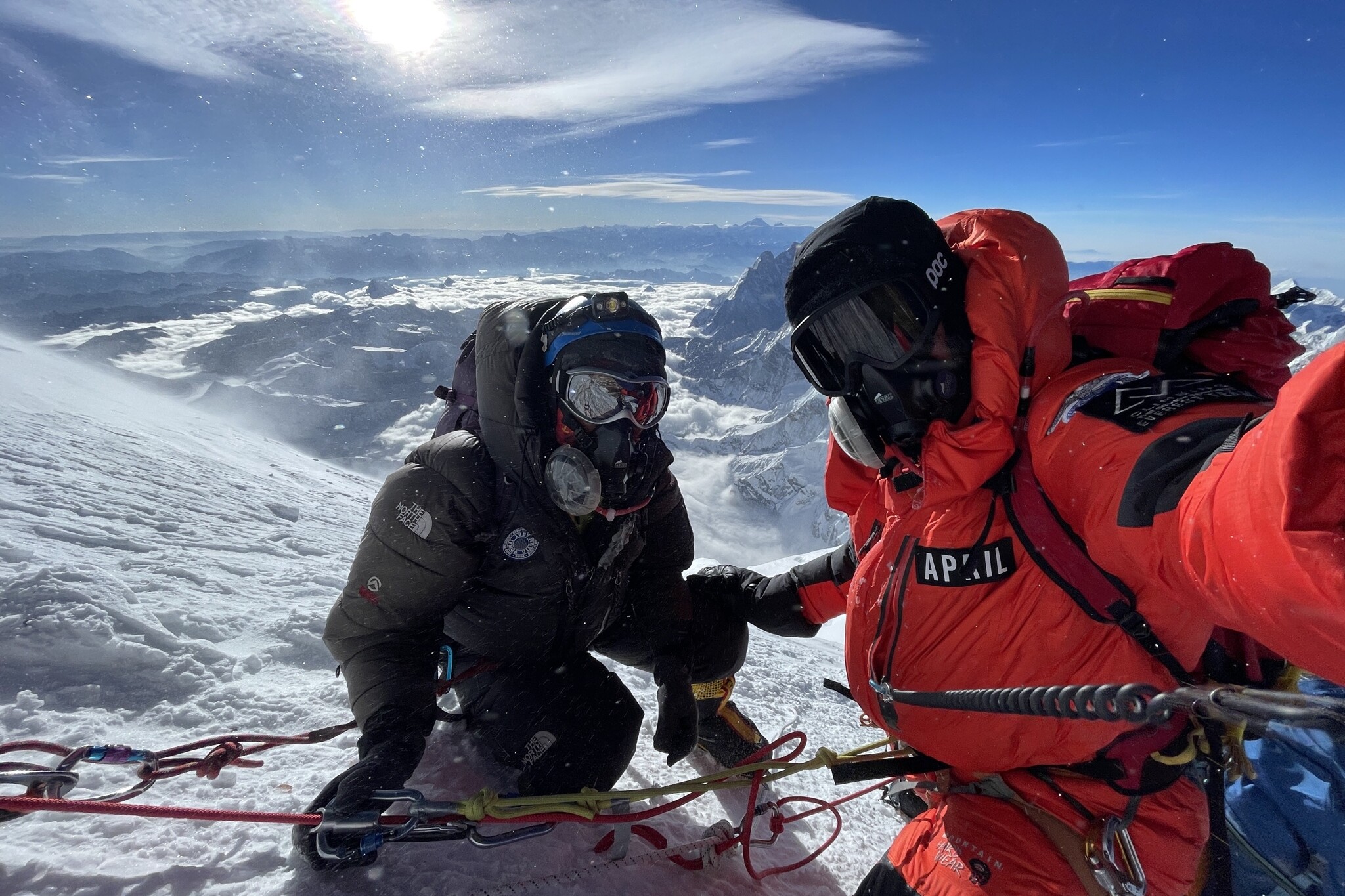
Price: $44,995 (Sherpa) – $84,995 USD (Western Guide)
Dates: Annually between April and May
Trip Length: 30-40 days (standard itinerary is 52 days)
Manaslu
Our Speed Ascent program is designed around a 32-day schedule. If you are pressed for time, we offer a more aggressive 22-day schedule. Please note that the shorter schedule requires more pre-acclimatization at home.
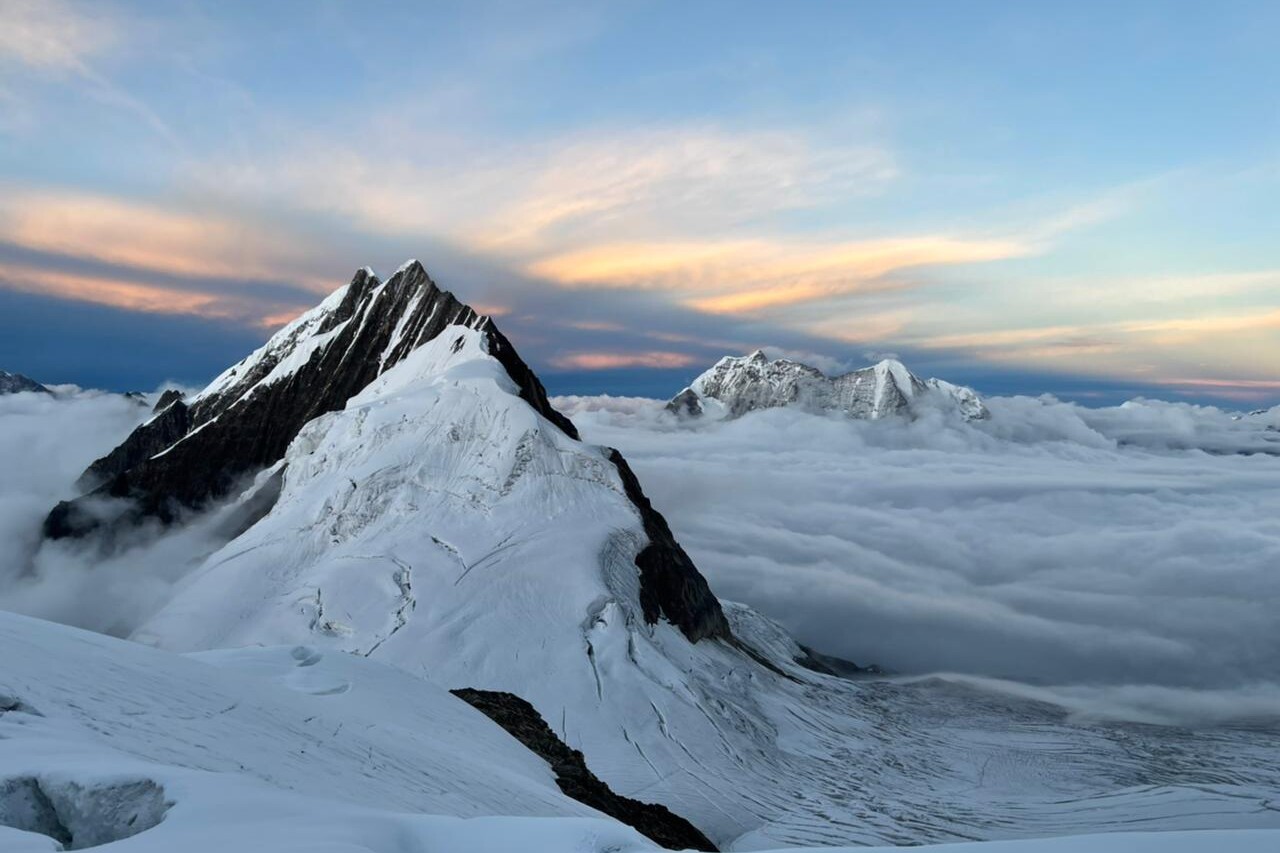
Price: $32,995 – $34,995 USD
Dates: Contact us for custom date planning
Trip Length: 22 or 32 days (standard itinerary is 42 days)
Are you looking for some strategies to help you acclimatize properly?
Head to our Understanding Acclimatization Resource page to learn more about high-altitude environments and don’t forget to check out our webinar below – Mountaineering 101: Understanding Acclimatization and High-Altitude.